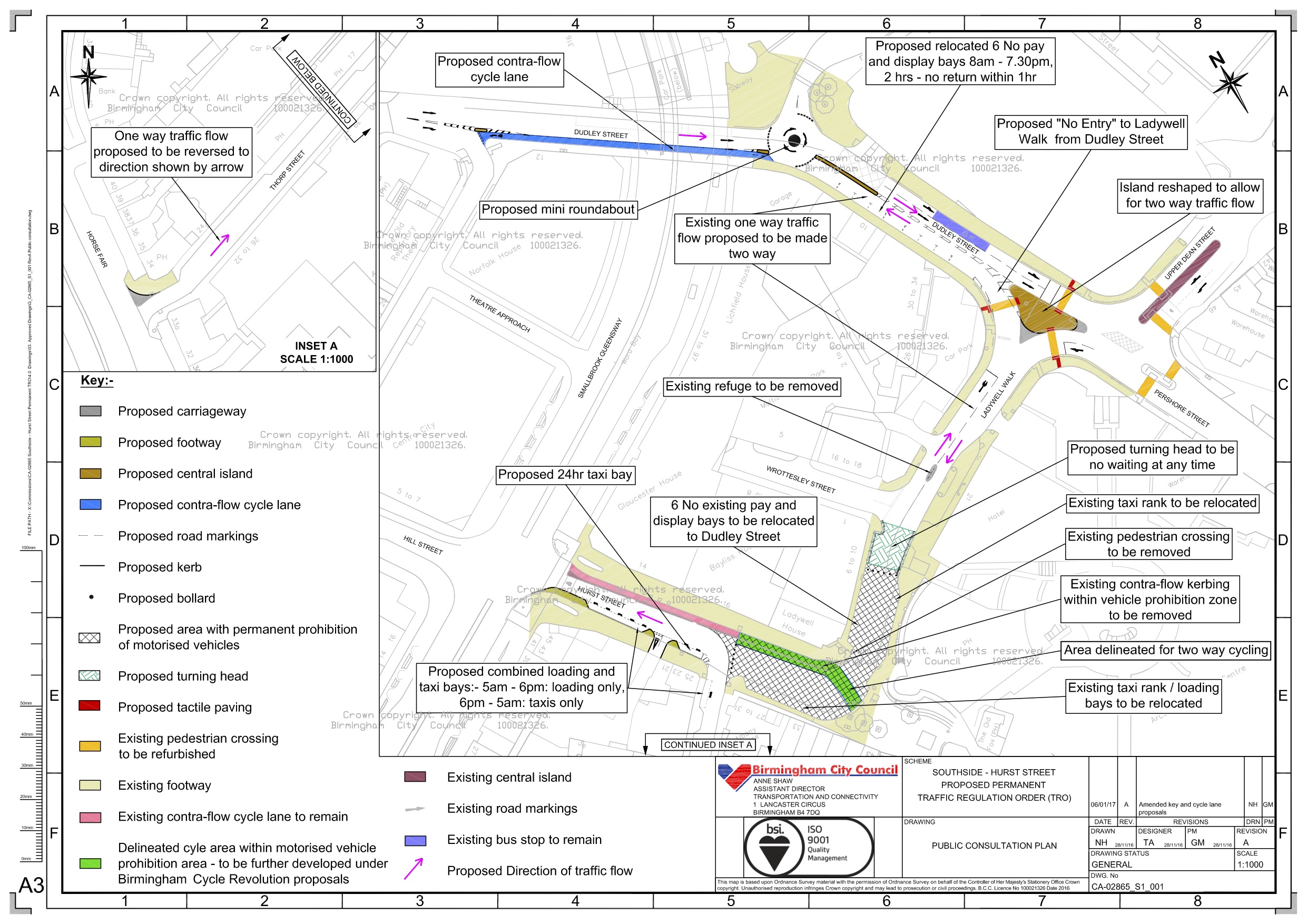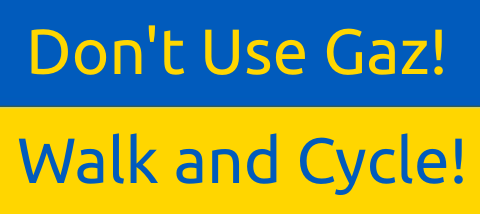
Birmingham City Council is consulting on changes to the highways on Hurst Street next to the Hippodrome, following a temporary arrangement that blocked motor traffic access from Hurst Street onto Smallbrook Queensway. Prior to the current temporary arrangement, Hurst Street carried a large volume of motor traffic through the city centre. That motor traffic flow has been mainly diverted away without making Birmingham city centre motor traffic seize up any more than it did before. This is a good example of how a temporary Traffic Regulation Order can be used to show the effects of a possible change and help people to get used to the changes being presented in a permanent Traffic Regulation Order.
The link for the consultation is here on the Birmingham BeHeard website, and the closing date for comments is Wednesday 1st February. Update: the consultation webpage is now saying that the closing date for comments is Friday 10th February.
Push Bikes' response:
We strongly support the ideas behind the proposals and the general scheme, and we think that the proposals are a positive step forward for Birmingham's city centre. However there are some issues with the scheme, particularly with the route from Edgbaston Street (next to the Bullring) to Hurst Street.
Points that need attention:
(1) Area delineated for two-way cycling in the pedestrianised area.
- It is encouraging to see this, as it will provide a legible layout that will help pedestrians predict where the cycle users will want to go. But it must be wide enough - a minimum of 3 meters wide - and it must be visibly a cycle space. The cycle lanes installed at the end of Colmore Row next to the tram lines perhaps do not give a strong enough visual clue to pedestrians, and so are regularly full of pedestrians.
- There needs to be a connection from Ladywell Walk to the Hurst Street cycle lane as well. Ladywell Walk will probably see a large increase in the amount of cycle traffic, and this route needs to be clear as well.
(2) Cyclists and taxis mixing on Hurst Street
- We expect that there will be a lot of taxis using the taxi ranks on Hurst Street. There is a potential for this to cause problems for cycle users when taxi drivers are more concerned about listening to where their fare wants to go, and exiting onto Smallbrook Queensway than they are about watching out for cycle users on that road.
- We suggest that the bi-directional cycle track continues along the whole length of Hurst Street to give cycle space away from the taxis. This will mean widening the track to a minimum of 3 meters by moving the kerb out. There is adequate width to do this.
- There is currently a 'cycles-only' phase on the traffic lights at the Hurst Street - Smallbrook Queensway junction. This should be retained, so that cycle users exit Hurst Street on the same phase as cycle users exit the contra-flow lane on Hill Street. This would separate the cycle users from the taxi traffic in time, and give the cycle users a better cycling environment without reducing capacity for motor traffic. Cycle users could safely cross over into Hill Street without having taxis racing to over take them.
(3) Accessing Hurst Street from Smallbrook Queensway
- There needs to be an exemption to the left-turn ban for cycle users travelling south on Smallbrook Queensway, so that they can legally enter Hurst Street at that junction.
(4) Permeability for cycles on Thorp Street
- Reversing the flow of motor traffic on Thorp Street to accommodate the taxi rank for the area is a good idea. Although we suggest that the lane for the taxi rank extends around the corner to give more space but also to make the end of the line visible to taxis on Thorp Street (so that they don't turn the corner on to Hurst Street and find no space to wait).
- However, sometimes a cycle user will want to access the business on Thorp Street, and in the immediate area of Bristol Street. For those cyclists, we recommend that a non-segregated cycle contra-flow is installed. This only needs minimal signs, but will ensure maximum permeability for cycle users.
(5) Cycle parking
- Please include some cycle stands on these streets. The provision in this area is inadequate even for existing levels of cycle use.
(6) Dudley Street:
Currently Dudley Street is one-way, but it will change to two-way (for almost the whole length for cycles and part way for motor traffic). This change opens up big possibilities for new routes for cycles through this area, increasing permeability greatly. There will also be large changes later on with the redevelopment of the markets area, which will further change traffic flows.
We are very pleased to see the increase in permeability for cycles, and the contra-flow lane is very nice, but there are some issues with the current design that will reduce the experience of people cycling and walking in this small area:
- Motor traffic travelling down Dudley Street from New Street will have 2 lanes for the whole length.
- The mini-roundabout will have 2 lanes of motor traffic crossing.
- Pedestrians will have to walk across 4 lanes of motor traffic (3 moving, and 1 parked)
- Cycle users travelling up Dudley Street towards New Street will be squeezed between parked cars and moving cars.
- Cycle users will not be able to turn right from Dudley Street into Ladywell Walk.
We realise that there may not currently be a large enough budget to make a lot of changes to kerb lines and pavements in Dudley Street, but with the re-development of the markets, there may be funds to improve the public realm in the immediate streets. Space could be marked off now with inexpensive temporary measures, with plans made to do these properly during the re-development.
(a) First of all, the 6 on-street parking spaces should be scrapped:
- On Dudley Street and Ladywell Walk, there are 1,029 off-street parking spaces available (Edgbaston Street car park, Wrottesley Street car park and the car park in front of China Court). Off Thorp Street there are another 64 spaces and 57 spaces in the Dudley Street car park. Slightly further away, there are 520 spaces in the Arcadian car park and 1,015 spaces at the Bull Ring car park. The 6 on-street car park spaces on Dudley Road represent 0.5% of the car park spaces immediately accessible.
- It is counter-productive to have 6 on-street car parking spaces on Dudley Street as when a driver is lucky enough to find an empty one, the ensuing manoeuvring will be hazardous to the many pedestrians, and will obstruct other vehicles. We suggest they be removed from the proposal. If disabled on-street parking spaces are needed, they can be provided on Edgbaston Street, where the passengers can get out without having traffic going past them.
(b) Second, we should improve conditions for pedestrians between Edgbaston Street and Ladywell Walk:
- This area of the city centre gets very crowded sees much pedestrian movement across across Dudley Street. Pedestrians attempt to cross the road following their desire line, rather than taking a detour via the crowded and slow controlled crossings. Four lanes for motor vehicles in an area where the pedestrian should be king is inappropriate and outdated.
- Instead, the north-bound side of Dudley Street should have a single lane that is narrow enough to prevent motor vehicle drivers from trying to pass cycle users (an acceptable compromise given the short length of this stretch). This should be a maximum of 2.75 meters, but if this section is not needed for wider delivery vehicles, the width could be 2.3 meters.
- The space recovered from from motor vehicles could be used to build a median strip, making pedestrian movement easier and safer, and less dominated by motor traffic.
- These changes open the door to making Dudley Street physically much more attractive (ie like Edgbaston Street) when funds are available.
(c) Third, permeability for cycles needs to be increased even further:
- The routes from Hurst Street along Ladywell Walk towards the markets are all quite good routes. The problems occur for cycle users who are travelling down Dudley Street and trying to turn right into Ladywell Walk. Although there are ways to get around this, the most direct route is down Ladywell Walk.
- There may be ways to use the central media strip to provide a safe space for cycles to turn into Ladywell Walk, perhaps through a shared space compromise. All motor traffic turning into and out of Ladywell Walk will need to be stopped for the pedestrian crossings, so those might be useable.
(d) Fourth, reduce the volume of motor traffic entering the mini-roundabout:
Mini-roundabouts should have a maximum of 1 lane of traffic circling them. This is important for cycle users so that they can navigate the mini-roundabout more easily. It is also important for motor vehicles drivers so that they clearly understand who has priority at all times. The approach to the mini-roundabout from New Street station has 2 lanes on Dudley Street, going into 2 lanes on the other side. This design will enable 2 lanes of traffic to flow over the roundabout, with vehicles driving over the white roundel in the middle. This will be a hostile environment for people who are cycling, so it needs to be changed.
- At the mouth of the roundabout from the direction of New Street, there should be a single lane for traffic. This will need to be achieved through physical measures, not only white paint.
- Ideally, Dudley Street should be just 1 lane from the junction with Hinckley Street, however the presence of bus stops means 2 lanes are necessary. Perhaps the bus stops could be moved up Dudley Street to allow for the road to be narrowed to one lane before it reaches the mouth of the roundabout.
- The mini-roundabout should be built to maximum height permissible to make sure that it discourages cars from driving straight over it.
(e) Fifth, sort out the exit of the contra-flow to Hinckley Street:
The contra-flow is a very welcome proposal which will provide an attractive alternative to waiting for the traffic lights at the Smallbrook Queensway crossroads. It is appropriate to have segregated contra-flow here because the volume of motor traffic will be high, and the use of Hinckley Street is an acceptable compromise, since it is only a very small diversion from the Station Street route. However, the angle at the end of the junction, however, is far too sharp and will cause a problem for people making that turn.
- The cycle track needs to be taken through the pavement build out, to give cycle users a gentler turning circle. Non-standard cycles may struggle to turn so sharply and the majority of cycle users will have to slow down significantly, losing their momentum in the turn. Pedestrians will find the cycle track easy to cross, so no formal crossing will be needed, just dropped kerbs or a gentle ramp.
- The clear cycle track must be kept, though, to give pedestrians the ability to predict where cycle users will go.
- The contraflow cycle track needs to be of adequate width (minimum two metres), to allow overtaking and sociable cycling. Given the width of Dudley Street, this should not be a problem.
(f) Finally, Dudley Street - Pershore Street junction correction:
There is a mistake on the plans here. There should only be 1 lane going straight-on, with the other lane being only a left-turn onto Upper Dean Street. This is important as the exit of this junction to Pershore Street is only 1 lane wide.
Hurst Street public square consultation



